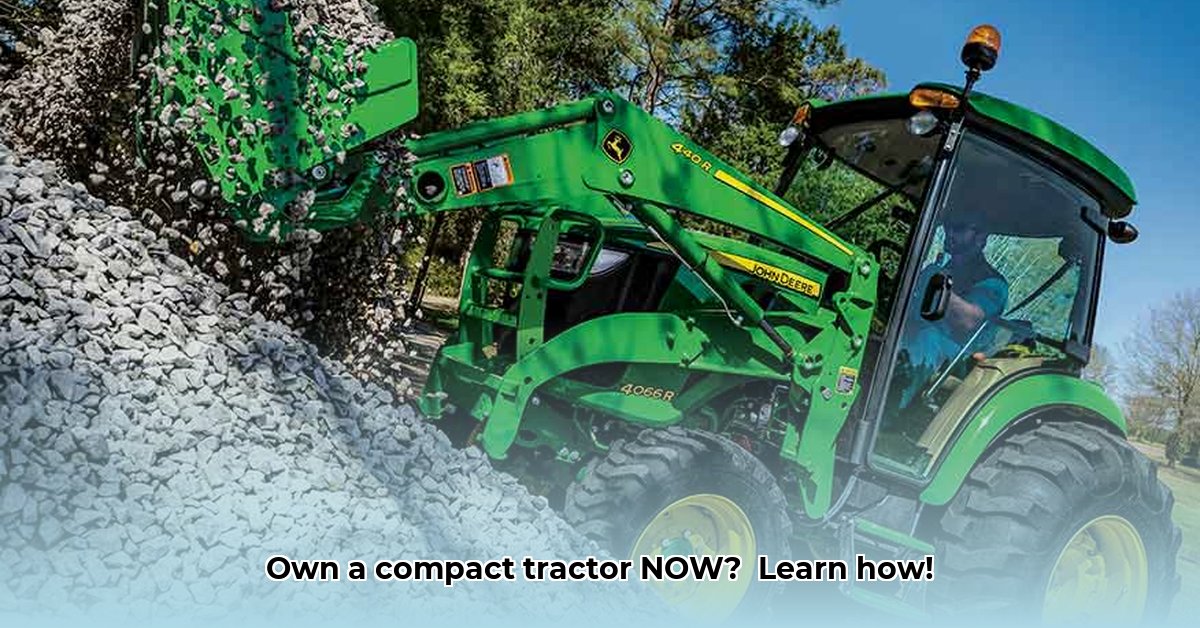
Rent to Own Compact Tractor: Your Path to Ownership
Considering purchasing a compact tractor but hesitant about the upfront cost? Rent-to-own (RTO) offers an alternative financing solution. This guide compares RTO with traditional leasing, empowering you to make an informed decision based on your specific needs. For more information on rent-to-own options with no credit check, see this helpful resource.
Understanding Rent-to-Own Agreements
Rent-to-own allows you to use a tractor immediately while making regular payments that contribute towards eventual ownership. It's a strategic approach to acquiring equipment without a large initial investment. However, total costs may exceed the market value of the tractor.
Key Aspects of Rent-to-Own:
Contract Length: Typical contracts range from 24 to 60 months, depending on the dealer and tractor model. Longer terms generally mean lower monthly payments but a higher overall cost. Is a longer contract length financially viable for your situation?
Payment Structure: Monthly payments consist of both rental and purchase components. A portion of each payment is allocated towards the final purchase price. Understanding the payment breakdown is crucial for budgeting.
Ownership Transfer: Once all payments are made, you acquire full ownership of the tractor. This is a significant advantage over leasing. How important is the ultimate ownership of the tractor to you?
Maintenance: Renters usually bear the responsibility for maintenance and repairs. Are you comfortable managing tractor maintenance, or would you prefer a lease with included maintenance?
Traditional Leasing: A Different Approach
Leasing provides access to a compact tractor for a predetermined period without the obligation of ownership. It's often a cost-effective option for short-term projects or when uncertainty shrouds future equipment needs.
Understanding Tractor Leases:
Lease Term: Lease terms typically last 24 to 36 months, offering shorter-term flexibility. This is ideal for projects with defined timelines. Does your project's duration align with the typical lease term?
Monthly Payments: Consistent monthly payments are standard. Are consistent monthly payments more manageable for your budget than larger, infrequent payments?
End-of-Lease Options: At lease expiration, you can return the tractor, renew the lease, or buy it at a predetermined buyout price. What's your anticipated equipment usage beyond the lease term?
Maintenance: Maintenance responsibility varies among lease agreements. Some include routine maintenance, while others require the lessee to cover all maintenance costs. Does the included maintenance in a lease contract justify the higher cost compared to rent-to-own?
Rent-to-Own vs. Leasing: A Direct Comparison
This table highlights the key differences between rent-to-own and traditional leasing:
| Feature | Rent-to-Own | Traditional Leasing |
|---|---|---|
| Initial Cost | Lower | Higher (often requires a down payment) |
| Monthly Payments | Potentially higher | Potentially lower |
| Total Cost of Ownership (TCO) | Can be higher or lower | Generally lower for short-term use |
| Tax Implications | Depreciation is a tax benefit | Lease payments are typically a business expense |
| Ownership at the End | You own the tractor | You don't own the tractor |
| Flexibility | Less flexible; you're committed | More flexible; options at lease end |
| Maintenance Responsibility | Usually the renter's | Often included in lease payments |
Calculating Total Cost of Ownership (TCO) is crucial. It encompasses all expenses over the equipment’s lifespan: initial cost, monthly payments, maintenance, repairs, and potential resale value. Accurate TCO calculation helps make an informed decision.
Critical Factors to Consider
Before committing to either financing option, ask yourself these questions:
Budget: How much can you comfortably allocate monthly, considering both payments and potential maintenance costs? A realistic budget assessment minimizes financial strain.
Project Duration: How long do you anticipate using the tractor? Short-term needs favor leasing; long-term use might justify rent-to-own. A precise timeline aids in informed decision-making.
Usage Frequency: How often will the tractor be needed? This influences overall costs and repair likelihood. Frequent use might favor the lower operational cost of a lease.
Creditworthiness: Your credit score impacts the terms you obtain from both RTO and leasing agreements. Strong credit enhances negotiation power.
Maintenance Capabilities: Do you possess the skills and resources for tractor maintenance, or would you prefer a lease with maintenance covered? Self-maintenance saves money but demands expertise.
Conclusion: Choosing Your Financing Path
The choice between rent-to-own and leasing a compact tractor necessitates careful consideration of your specific needs and financial situation. It’s imperative to analyze the total cost of ownership (TCO) to determine which option aligns best with your budget and long-term goals. A thorough cost analysis prevents unexpected expenses and ensures a financially sound decision. Consult financial advisors for personalized guidance.